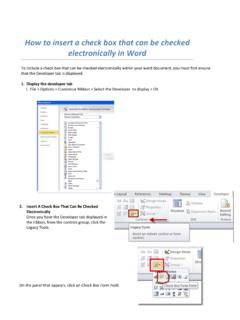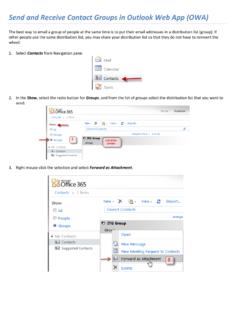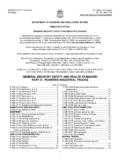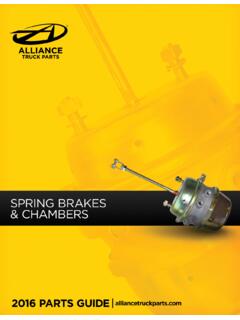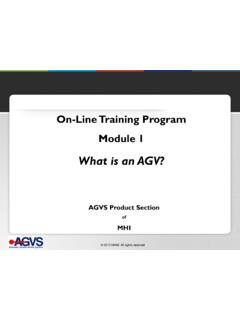Transcription of Professional Truck Driver Training Course Syllabus
1 Professional Truck Driver Training Course Syllabus The curriculum standards of this Course incorporate the curricular recommendations of the U. S. Department of Transportation's Federal Highway Administration's former Office of Motor Carriers Model Curriculum. The curriculum standards represent the minimum Training elements that a commercial motor vehicle Driver - Training Course should contain, and against which any such Course may be judged. The curriculum that the Nebraska Safety Center uses also meets the three sets of standards that the Professional Truck drivers Institute (PTDI established: skill standards; curriculum standards and guidelines; and standards and requirements for Course certification.)
2 1. Orientation The purpose of this section is to introduce the student to the trucking industry and present the concepts of industry regulation and the Professional Driver a. Objectives At the end of this section, the student should know/understand: i. The Importance of the Trucking industry ii. The Importance of Compliance with Applicable Regulations iii. Procedure for Obtaining a CDL. iv. The Driver Qualifications They are Subject to in the industry v. The Commercial Motor Vehicle 2. Control Systems The purpose of this section is to introduce students to the controls and instruments found on a commercial motor vehicle.
3 Stress the importance of understanding the function of all of the vehicle's controls and instruments prior to operating the vehicle. a. Objectives At the end of this section, students should have the basic understanding of the name, location, and function of the vehicles controls and systems. The student should be able to: i. Describe the engine controls as well as the primary and secondary vehicle controls ii. Identify and describe the controls for starting the engine, shifting, accelerating, braking, and parking iii.
4 Explain the acceptable operating range for oil, coolant, and electrical systems iv. Identify and describe all vehicle instruments and their purpose 3. Vehicle Systems The purpose of this section is to introduce the student to the design of a tractor-trailer and the vehicle's key systems and parts. a. Objectives Upon completion of this section the student will have basic understanding of the vehicle construction and systems including: i. Suspension Systems ii. Axles iii. Engine iv. Fuel System v. Air Intake and Exhaust System vi.
5 Lubrication System vii. Cooling System viii. Electrical System ix. Drive Train x. Brake System xi. Wheels and Tires xii. Steering System xiii. Coupling System 4. Vehicle Inspection In this section the student will learn the importance of conducting appropriate and systematic vehicle inspections. a. Objectives At the end of this section the student should know and understand: i. How to use systematic procedure to conduct accurate and efficient vehicle inspection ii. How to identify damaged, loose, or missing parts iii.
6 How to recognize and report system defects iv. Why an undiscovered malfunction or vehicle problem can be unsafe and costly v. The importance of having malfunctions corrected quickly vi. Federal Motor Carrier Safety Regulations (FMCSR) regarding vehicle inspections vii. Procedures for performing Post trip inspections 5. Basic Control In this section the student will learn how to safely preform the basic control maneuvers. These skills are the foundation that the student will build upon throughout the Course .
7 These skills and habits will be practiced throughout the Course . a. Objectives By the end of this section, the student will know and understand the following: i. How to start, warm up, and shut down the engine ii. How to putt vehicle in motion and how to stop the vehicle iii. Proper straight line backing technique iv. Proper turning technique 6. Shifting This section will teach students shifting patterns, and procedures so they can efficiently perform gear shifting maneuvers. a. Objectives At the end of this section, the student should be able to: i.
8 Shift up and down through the gears of a variety of types of conventional transmissions. ii. Double clutch and time shifts, allowing for a smooth and fuel efficient performance iii. Select proper gear for speed and highway conditions Students should also know and understand: i. Shifting procedures for transmissions ii. The instruments and controls used to properly shift gears iii. The shift patterns for the major types of conventional transmissions 7. Backing In this section, students learn to execute on of the most difficult maneuvers in trucking, backing a tractor-trailer unit.
9 A. Objectives At the conclusion of this section a student should know and understand: b. The basic principles of steering a tractor-trailer c. The basic rules for safe backing d. The basic backing maneuvers including straight line and alley dock backing e. The basic parking maneuvers including parallel parking 8. Coupling and Uncoupling In this section the step-by-step procedures used to couple and uncouple the most standard tractor-trailer combination units. a. Objectives At the end of this section students should be able to safely and efficiently couple and uncouple a tractor-trailer and double trailers.
10 The student should know the following: i. The step-by-step procedures for proper coupling and uncoupling of tractor-trailer combinations, including: selecting a site, aligning the tractor, securing the trailer against movement, connecting and disconnecting air and electrical lines, setting air brake controls, backing the tractor onto the kingpin, and retracting and extending the landing gear ii. The special procedures and consideration when coupling and uncoupling tractor and double trailer combinations iii.


